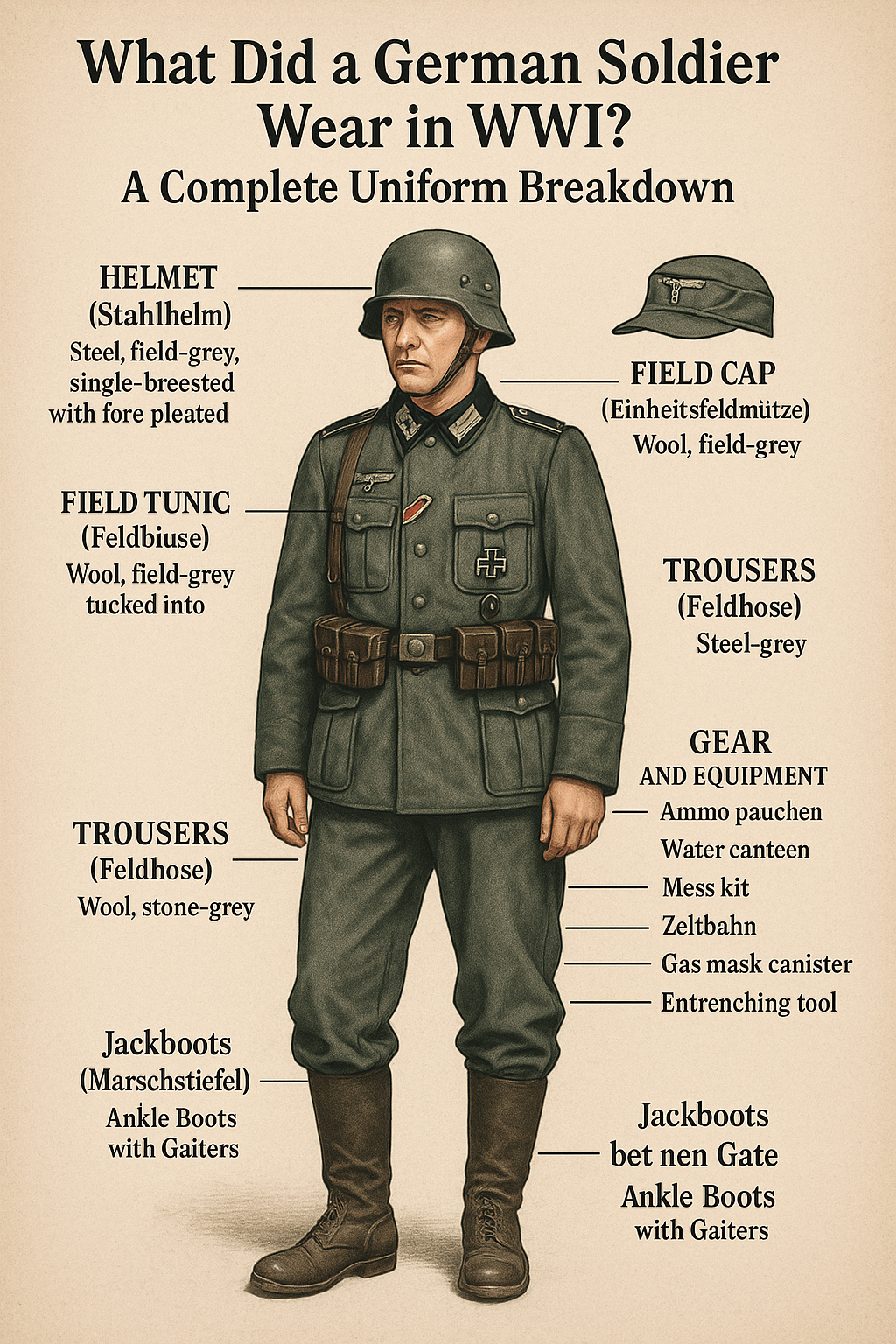
What Did a German Soldier Wear in WWII? A Complete Uniform Breakdown
Published on Jun 29, 2025
What Did a German Soldier Wear in WWII? Uniform Breakdown
Introduction
World War II was not just a battle of weapons and strategy—it was also a war of identity, and uniforms played a central role. The German soldier WWII uniform was instantly recognizable, with clean lines, iron discipline in its presentation, and chilling symbolism.
This wasn’t by accident. The uniform was designed to serve both practical combat needs and psychological warfare, presenting German soldiers—particularly the Wehrmacht and SS—as an unstoppable force. But what did these uniforms really look like? How did they change from 1939 to 1945? And why are they still studied and collected today?
Let’s explore the full story behind one of the most iconic and controversial military outfits in modern history.
1. The Purpose Behind the Uniform
A soldier’s uniform must serve several key functions:
- Practicality: Durable in the field, adaptable to seasons
- Identification: Rank, role, and allegiance had to be instantly visible
- Psychological Impact: Appear organized, unified, and intimidating
- Propaganda: In Nazi Germany, the uniform was part of national identity
The WWII German uniform was built with these goals in mind, evolving over the course of the war from tailored and resource-rich to mass-produced and utilitarian.
2. The Standard German Soldier Uniform: A Breakdown
Here’s a closer look at what the average German Wehrmacht infantry soldier would wear during WWII:
a. Field Tunic (Feldbluse)
The German tunic was the uniform’s core piece, typically made of heavy wool in a field grey color.
- M36 Model: High-quality wool, dark green collar, pleated pockets
- M40–M44 Models: Simplified designs with lighter colors and cheaper materials
Tunic features included shoulder boards, breast eagles, and collar tabs.
b. Trousers (Feldhose)
Matching wool trousers came in a stone-grey color, designed for durability. Early trousers were wide and tucked into boots; later ones became more fitted.
c. Helmet (Stahlhelm)
The M35 steel helmet offered protection and instantly identified a German soldier. With its iconic flared shape, it symbolized discipline and strength.
Later helmet models (M40, M42) were simplified but retained their intimidating design.
d. Footwear
- Early War: Jackboots (Marschstiefel), knee-high black leather boots
- Late War: Ankle boots (Schnürschuhe) with canvas gaiters due to leather shortages
e. Field Cap
A soft wool cap with a fold-down ear flap for cold weather. Officers often wore the more formal "Schirmmütze" peaked cap.
f. Gear and Equipment
The belt and suspenders system supported combat gear:
- Ammo pouches
- Water canteen
- Mess kit
- Gas mask canister
- Entrenching tool
- Zeltbahn (tent quarter)
3. Insignia and Symbols: A Language of Its Own
The Nazi military invested heavily in visual identity. Uniform insignia allowed soldiers to quickly identify friend, foe, and rank.
- Eagle & Swastika (Hoheitszeichen): Worn above the right breast pocket
- Shoulder Boards: Indicated rank
- Collar Tabs: Branch of service (e.g., infantry, panzer, artillery)
- Sleeve Shields: For foreign volunteers or specific units
- Cuff Titles: For elite SS units (e.g., “Totenkopf” or “Leibstandarte”)
These symbols were designed to project authority and conformity, aligning with Hitler’s vision of a fearsome, unified fighting force.
4. Variations Across Military Branches
Each division of the German armed forces had its own uniform colors and distinctions.
a. Wehrmacht Heer (Army)
- Field-grey wool
- Standard green collars (early models)
- Most widely issued and photographed
b. Luftwaffe (Air Force)
- Blue-grey uniforms
- Pilot jackets, flight suits, parachutist gear
c. Kriegsmarine (Navy)
- Deep navy blue
- Sailor collars, gold trim
- Unique peacoats for U-boat crews
d. Waffen-SS
- Field-grey, often with distinct SS runes and death’s head insignia
- Advanced camouflage (oak leaf, plane tree, pea dot)
- Reputation for being an elite political-military hybrid force
5. Camouflage Innovations and the SS Uniform
The Waffen-SS were pioneers of camouflage in combat. Unlike the Wehrmacht, which maintained traditional colors, the SS experimented with numerous camouflage patterns:
- Dot 44 ("Erbsenmuster")
- Oak Leaf Patterns (Eichenlaubmuster)
- Plane Tree (Platanenmuster)
These uniforms were reversible (summer and snow) and became a model for modern combat uniforms.
6. Decline in Quality as War Progressed
At the war’s outset, German uniforms were superior in quality to most other armies. But by 1943, with Allied bombings and resource shortages, Germany had to cut costs.
- Wool replaced by cotton or synthetic blends
- Uniforms simplified with fewer buttons and pleats
- Quality control dropped, especially in late-war production
7. Reproductions, Collectibles & Modern Legacy
Today, WWII German uniforms are popular among:
- Reenactors
- Militaria collectors
- Museums and historical educators
- Film and television productions
Conclusion
The German soldier WWII uniform is more than just fabric and thread—it’s a symbol of one of the most impactful and tragic chapters in human history. Every insignia, color, and design choice was part of a larger system that sought power, order, and dominance.
While its aesthetic and military functionality were undeniably advanced, it is critical to view these uniforms through a lens of historical responsibility. Understanding what they were—and what they represented—helps us keep the memory of the past alive, and ensures that history is preserved, not repeated.
Whether you're a historian, collector, or simply curious, studying these uniforms offers a unique insight into how clothing can become both a weapon and a message.
